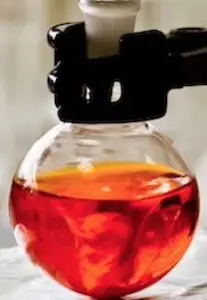Written by J.A Dobado | Last Updated on April 22, 2024
What is a mixture?
In Chemistry, a mixture is defined as a material consisting of two or more different chemical substances that are not chemically combined and where each of them retains its identity and properties.
A mixture is the physical combination of two or more substances in which identities are retained and they are mixed in the form of solutions, suspensions and colloids.

Mixtures are a product of combining chemical substances such as elements and compounds, without chemical bonds or other chemical changes, so that each ingredient substance retains its own chemical properties and composition.
Although there are no chemical changes in its components, the physical properties of a mixture, such as its melting point, may differ from those of the components.
Some mixtures can be separated into their components using physical (mechanical or thermal) procedures.
Azeotropes are a type of mixture that often rise considerable difficulties in terms of the separation processes required to obtain their constituents (physical or chemical processes or even a combination of them).
Properties of mixtures
Mixtures can be characterized as separable by mechanical procedures (e.g. purification, distillation, electrolysis, chromatography, heat, filtration, gravity sorting, centrifugation).
In addition, mixtures differ from chemical compounds as follows:
- Substances in a mixture can be separated using physical methods such as filtration, freezing and distillation.
- There is little or no energy change when a mixture is formed.
- Mixtures have variable compositions, whereas compounds have a definite and fixed formula.
- When mixed, individual substances maintain their properties in a mixture, whereas if they form a compound, their properties may change.
Examples of mixtures
The following table shows the main properties and examples of all possible phase combinations of the three “families” of mixtures:
| Dispersion medium | Disperse phase | Examples |
| gas | gas | Gas mixture: air (oxygen and other gases in nitrogen) |
| liquid | Liquid aerosol: vapor, mist, spray. | |
| Solid | Solid aerosol: smoke, ice cloud, particulate air. | |
| liquid | gas | Solution: oxygen in water. |
| liquid | Solution: alcoholic drink. | |
| Solid | Solution: sugar in water. | |
| Solid | gas | Solution: hydrogen in metals. |
| liquid | Solution: amalgam (mercury in gold) | |
| Solid | Solution: alloys, plasticizers in plastics. |
Classification of mixtures
Homogeneous mixtures
A mixture in which the components are evenly distributed, like salt in water, is called homogeneous.
Heterogeneous mixtures
A mixture whose components are clearly separated from each other, such as sand in water, is called heterogeneous.
Uniform mixture
Uniform mixture is another synonym for homogeneous mixture and “non-uniform mixture” is another term for heterogeneous mixture.
These terms are derived from the idea that a homogeneous mixture has a uniform appearance, or only one visible phase, because the particles are uniformly distributed.
However, a heterogeneous mixture has a non-uniform composition and its constituent substances are easily distinguishable from each other (often, but not always, in different phases).
Video about Mixtures
Solutions
Various solid substances, such as salt and sugar, dissolve in water to form a special type of homogeneous mixture called a solution, in which both a solute (dissolved substance) and a solvent (dissolution medium) are present.
Air is also an example of a dissolution: a homogeneous mixture of gaseous nitrogen solvent, in which oxygen and smaller amounts of other gaseous solutes are dissolved. Mixtures are not limited either in their number of substances or in the amounts of those substances, although in a homogeneous mixture the ratio of solute to solvent can only reach a certain point before the mixture separates and becomes heterogeneous.
A homogeneous mixture is characterized by the uniform dispersion of its constituent substances throughout; the substances exist in equal proportions in all parts of the mixture. In short, a homogeneous mixture will be the same no matter where in the mixture it is sampled.
For example, if a solid-liquid solution is divided into two halves of equal volume, the halves will contain equal amounts of both the liquid medium and the dissolved solid (solvent and solute).
In physical chemistry and materials science, “homogeneous” more narrowly describes substances and mixtures that are in a single phase.
A solution is a special type of homogeneous mixture where the ratio of solute to solvent remains the same throughout the solution and particles are not visible to the naked eye, even if homogenized with multiple sources. In dissolutions, solutes do not settle out after a period of time and cannot be removed by physical methods, such as a filter or centrifuge. As a homogeneous mixture, a solution has one phase (solid, liquid or gas), although the solute and solvent phase may initially have been different (e.g., salt water).
FAQ
What is a mixture and example?
According to the definition, a mixture is the combination of two or more substances in which each of them retains its distinctive properties. Sometimes it is very easy to realize that there is a mixture because you can see it with the naked eye, as when water is mixed with other components such as oil or sand.
What is a homogeneous mixture?
A homogeneous mixture is a type of mixture in which the components are indistinguishable and in which the composition is uniform and each part of the solution has the same properties.